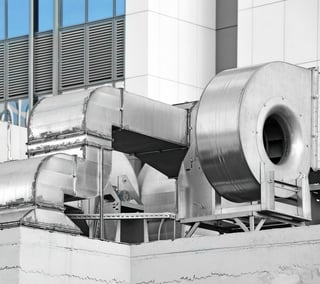All induced draft, forced draft aerators, degasifiers, and odor control scrubbers rely on some type of air blower to enhance removal efficiency or move airflow. When a change in performance is noticed in water effluent quality, the first thing to inspect and troubleshoot is your blower.
An induced draft inspection, at times, can be a bit more tricky because it is located on top of the unit and typically requires some type of access ladder to allow for an inspection. You must always follow proper OSHA safety guidelines when attempting to inspect. Larger units often come equipped with an attached access ladder and handrail system, whereas small units with limited space do not.
The forced draft units have the blower typically mounted on the ground or top of the Clearwell/catch tank so that access to inspect a forced draft blower is less complicated. Once reaching the blower, if the noise of other operating equipment prevents easy listening, place your hand on top of the blower housing to detect if the motor is running. You will feel a vibration from the housing. If the water flows to the unit, but the blower is off and not running, you can determine that the motor is not operating.

Blower Motor Not Operating Procedure
After making this determination inspect the most apparent items first:- Check the control panel and ensure the blower switch is in the “on” or “auto” position.
- Next, inspect the electrical circuit breaker panel using proper safety protocols and OSHA guidelines to ascertain if the breaker has tripped.
If you have not identified the problem after these first few steps, you will need the proper training and certifications to go to the next step and perform an electrical inspection. If no other in-line fuses provide power to the blower, then you will need to run diagnostics on the blower motor starter located within the control panel using an electrical testing meter.
For safety reasons, this blog will not provide you with the step-by-step procedure to perform this test because only qualified and certified electrical technicians should venture into the control panel.
Verify that the power is provided to the starter and is “engaging.” Next, verify that power is flowing from the starter properly. If your diagnostics has not identified an electrical problem, the next step is to perform a diagnostic on the electrical motor located within the blower unit.
- Using proper OSHA guidelines, turn off the power and secure the electrical.
- Open the access panel or remove the blower housing to expose the motor.
- Next, perform a diagnostic test on the motor to identify if the motor has failed and needs to be replaced. If it fails, contact the unit manufacturer or your local supplier and replace the motor with an identical unit.
Blower Motor Operating and Not Performing Procedure
If your blower was operating when you performed the first inspection, it may indicate that the blower motor belt has been worn and damaged and needs to either be tightened or replaced.
- Follow the same procedures identified above and properly secure the power in the off position using a “lock out- tag out” OSHA procedure.
- Then remove the housing and inspect the belt. If it is very loose, then adjust the belt to tighten. If the belt is very worn or off or broken, then replace the belt.
Blower Motor Running and Belt Is Operation Procedure
If you have inspected the blower and its essential components and determined that it is fully operational and still not moving air or the unit is not performing, this can indicate a more severe problem within the unit itself.
- First, verify if you have a screen on the blower and that it is clean or on the discharge screen of the unit.
- The next step will be to contact a factory representative and schedule an internal inspection and/or cleaning of the equipment since the internal media may be fouled so severely that the airflow is blocked. Some units come equipped with a pressure gauge, so if proper record keeping has been maintained, reviewing pressure records may help identify the problem.
For more information or to learn about water treatment, contact the professionals at DeLoach Industries Inc. at (941) 371-4995.
Related Blog: How Degasification Can Solve Your Water Treatment Issues




